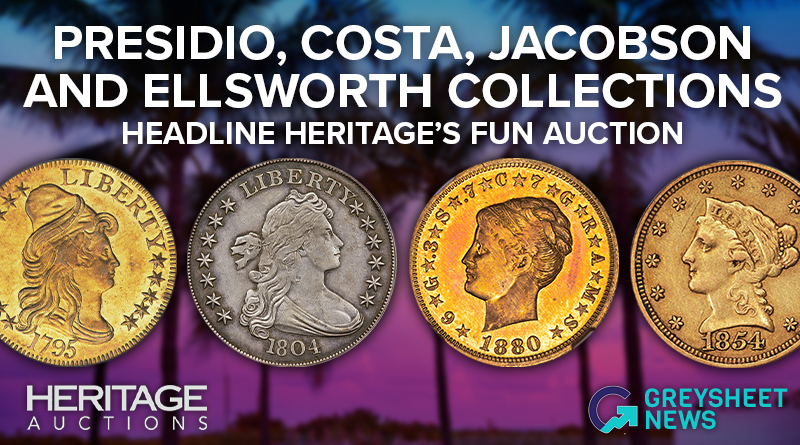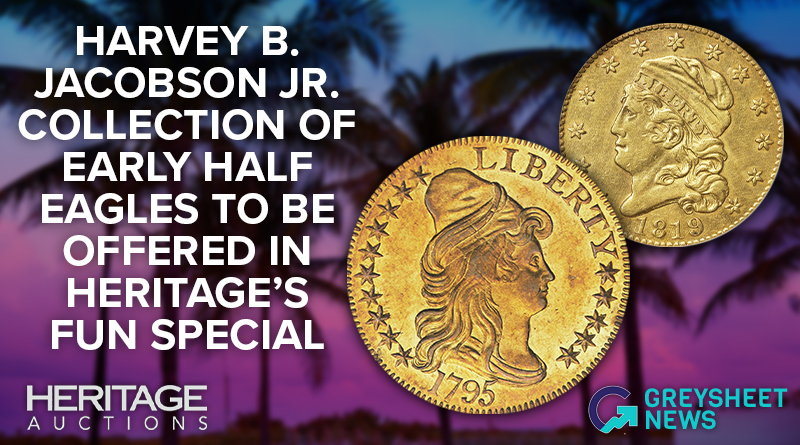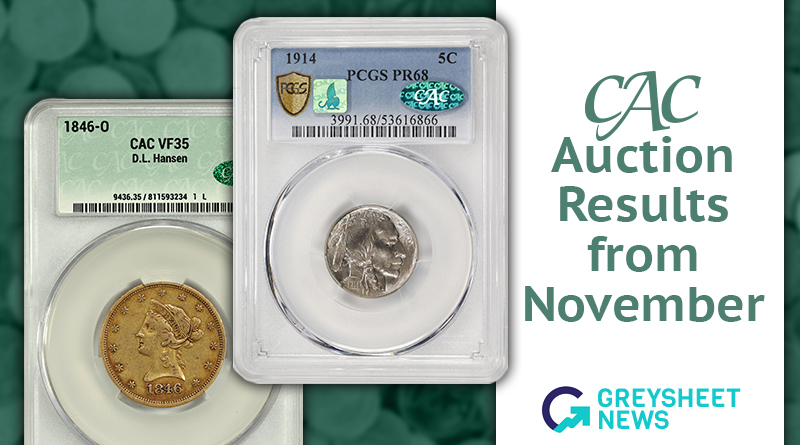Greysheet & CPG® PRICE GUIDE
- U.S. Coins /
- Pattern Coinage /
-
Patterns (1836) Values
About This Series
History and Overview
On March 23, 1836, the first steam-powered coining press at the U.S. Mint was inaugurated. Cents were struck by steam power in that month, and on November 10, the first silver coins were struck on steam presses. Many processes were improved and mechanized, including the making of dies.
In 1836, patterns came to the forefront, creating the first truly grand year after 1792 in the series. We see the emergence of Christian Gobrecht’s Liberty Seated design and, in strictly pattern form, the production of coins of the two-cent and gold dollar denominations. The Liberty Seated issues in particular set the stage for later coinage.
The Liberty Seated/Flying Eagle Design of 1836
In 1835, well-known local artists Titian Peale and Thomas Sully had received commissions to prepare sketches for new coin designs, to be used by the engraver in making models. Patterson felt that the traditional figure of a goddess, seated, would be ideal, this having been used on coinage of other lands for generations, including Great Britain and ancient Rome. A sketch of this concept was created by Chief Engraver William Kneass shortly before he suffered a stroke. Sully and Peale made revisions, gave them to Gobrecht, and on October 15, 1836, an impression on or from a copper plate was sent to Treasury Secretary Levi Woodbury for review.
Work progressed, and on January 28, 1836, impressions or strikings or splashings from an obverse die were sent to Woodbury and to President Andrew Jackson for their approval, which was granted. Some further discussion concerning the treatment of the seated figure took place at the Mint, and a few revisions were made, including to the position of the pole supporting the liberty cap. By April 9, 1836, a revised obverse die was created.
Die Alignments of Gobrecht Dollars (1836–1839)
The die alignment of a Gobrecht dollar can be a guide to the time it was struck. Students of the series are divided in their opinions, and in the future there may be revisions of the following text, first presented in the ninth edition:
To test for die alignments I and III hold the coin, obverse up, by the edges at 9 o’clock and 3 o’clock; rotate along this horizontal axis and notice the position of the eagle. If the eagle is belly up, test for die alignment II and IV by holding the coin (obverse up) at the 12 o’clock and 6 o’clock edges between thumb and forefinger, rotate along this vertical axis, and note the position of the eagle. These procedures will yield one of the four alignments below:
Alignment I, coin turn: The eagle flies slightly upward (“onward and upward”); the two circular dots or pellets (one each side of ONE DOLLAR) are level after rotation along the horizontal axis. The head of Miss Liberty on the obverse is opposite the O in DOLLAR on the reverse. This is also called “coin turn” and is used on most United States coins.
Alignment II, medal turn: The reverse die is oriented 180 degrees differently from the preceding. This alignment is also called “medal turn” and is used on many medals (but only few circulating U.S. coins). The eagle flies “onward and upward” to the left, and the two ornaments flanking ONE DOLLAR are level after rotating along the vertical axis. The head of Liberty is opposite the E in STATES on the reverse.
Alignment III: The eagle flies horizontally, thus the two pellets on each side of ONE DOLLAR are not level (the one on the left is lower) after rotating the coin along the horizontal axis. The head of Liberty is opposite the N in ONE on the reverse.
Alignment IV: The eagle flies horizontally as preceding, after rotation along the vertical axis. The head of Liberty is opposite the space between F in OF and first A in AMERICA on the reverse.
Pattern Two-Cent Pieces of 1836
Although the Gobrecht silver coinage of 1836 has captured the most attention of numismatists and is the most important historically, in the same year, two new denominations were made in pattern form: the two-cent piece and the gold dollar.
Pattern Gold Dollars of 1836
Early in 1836, while work was being done on dies for the silver dollar, pattern gold dollars were struck, these employing the Liberty Cap and Rays motif used by Gobrecht on his February 22, 1836 medal (overdated to March 23) for the inauguration of the steam press. Patterns of the new gold dollar were ready by March 14, 1836. The gold dollar denomination may have attracted slight interest at the time.
Collecting Perspective
The year 1836 offers the earliest dated patterns of which several different true patterns (not private restrikes) are available to collectors today. Today, restrikes exist of the 1836 two-cent piece, the Gobrecht silver dollar with the name below the base (and also the variety with the name on the base), and the gold dollar. In addition, some novodel (or combination of dies that were never used originally) silver dollar patterns exist combining the two different Gobrecht obverse dies with a reverse die without stars—in effect creating a completely starless issue.
A representative example of the 1836 two-cent piece can be obtained without difficulty, although examples are scarce. The market makes little differentiation between originals and restrikes.
The regular-issue 1836 Capped Bust half dollar with reeded edge has been “adopted” into the pattern series and listed as such for generations, although it has no pattern status.1 Gobrecht silver dollars of the regular issue (J-60), fondly adopted into the pattern series and for a long time considered to be patterns, exist by the hundreds, and are in great demand due to their distinctive design. The majority of specimens of J-60 are in grades from VF through Proof-55 or so. At least four different die alignments and variations occur for the J-60 1836 Gobrecht dollar with the name on the base and with stars on the reverse, and it is a challenge to determine when they might have been struck.
The true patterns are those with the legend C. GOBRECHT. F below the base and above the date. This legend is an abbreviation of “C. Gobrecht Fecit,” Latin for “C. Gobrecht Made It.” Restrikes, quite rare, are encountered from time to time. The various restrikes of 1836, some from die pairs never originally used in 1836, are all extreme rarities.1
Gold dollars of 1836, actually struck in gold, exist to the extent of perhaps as many as 50 to 75 pieces, some original and others restrikes made circa 1859. Restrikes exist in other metals as well. Gold strikings with silver alloy were made in January 1844 to review the concept of the gold dollar denomination. These are restrikes, but were made from the original dies in the course of normal Mint activities, not to create pieces for collectors.
Interestingly, the only two readily available collectible “patterns” dated 1836 are J-57 and J-60, described below, each of which is really a regular issue that has been adopted by pattern collectors.
Catalog Detail
Legal Disclaimer
The prices listed in our database are intended to be used as an indication only. Users are strongly encouraged to seek multiple sources of pricing before making a final determination of value. CDN Publishing is not responsible for typographical or database-related errors. Your use of this site indicates full acceptance of these terms.











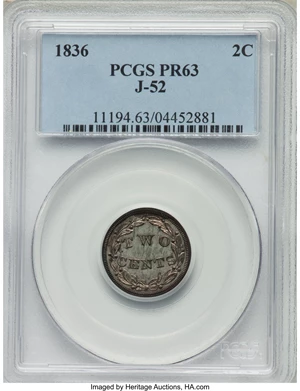
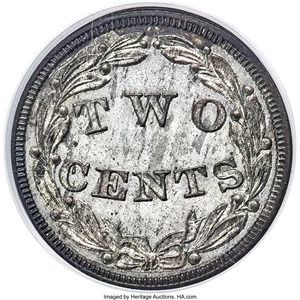
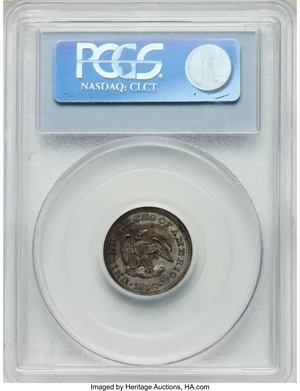
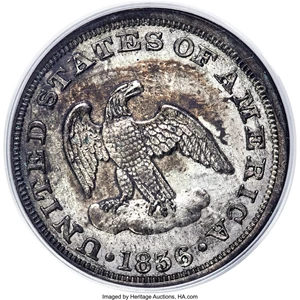





From the Greysheet Marketplace
Buy Now: $3,695.00
Buy Now: $2,890.63
Buy Now: $120,000.00
Buy Now: $38,900.00
Buy Now: $5,500.00
Buy Now: $37,000.00
Buy Now: $3,121.88
Buy Now: $37,000.00
Buy Now: $31,500.00
Buy Now: $125,000.00
Related Stories (powered by Greysheet News)
View all news
Greysheet Catalog Details
History and Overview
On March 23, 1836, the first steam-powered coining press at the U.S. Mint was inaugurated. Cents were struck by steam power in that month, and on November 10, the first silver coins were struck on steam presses. Many processes were improved and mechanized, including the making of dies.
In 1836, patterns came to the forefront, creating the first truly grand year after 1792 in the series. We see the emergence of Christian Gobrecht’s Liberty Seated design and, in strictly pattern form, the production of coins of the two-cent and gold dollar denominations. The Liberty Seated issues in particular set the stage for later coinage.
The Liberty Seated/Flying Eagle Design of 1836
In 1835, well-known local artists Titian Peale and Thomas Sully had received commissions to prepare sketches for new coin designs, to be used by the engraver in making models. Patterson felt that the traditional figure of a goddess, seated, would be ideal, this having been used on coinage of other lands for generations, including Great Britain and ancient Rome. A sketch of this concept was created by Chief Engraver William Kneass shortly before he suffered a stroke. Sully and Peale made revisions, gave them to Gobrecht, and on October 15, 1836, an impression on or from a copper plate was sent to Treasury Secretary Levi Woodbury for review.
Work progressed, and on January 28, 1836, impressions or strikings or splashings from an obverse die were sent to Woodbury and to President Andrew Jackson for their approval, which was granted. Some further discussion concerning the treatment of the seated figure took place at the Mint, and a few revisions were made, including to the position of the pole supporting the liberty cap. By April 9, 1836, a revised obverse die was created.
Die Alignments of Gobrecht Dollars (1836–1839)
The die alignment of a Gobrecht dollar can be a guide to the time it was struck. Students of the series are divided in their opinions, and in the future there may be revisions of the following text, first presented in the ninth edition:
To test for die alignments I and III hold the coin, obverse up, by the edges at 9 o’clock and 3 o’clock; rotate along this horizontal axis and notice the position of the eagle. If the eagle is belly up, test for die alignment II and IV by holding the coin (obverse up) at the 12 o’clock and 6 o’clock edges between thumb and forefinger, rotate along this vertical axis, and note the position of the eagle. These procedures will yield one of the four alignments below:
Alignment I, coin turn: The eagle flies slightly upward (“onward and upward”); the two circular dots or pellets (one each side of ONE DOLLAR) are level after rotation along the horizontal axis. The head of Miss Liberty on the obverse is opposite the O in DOLLAR on the reverse. This is also called “coin turn” and is used on most United States coins.
Alignment II, medal turn: The reverse die is oriented 180 degrees differently from the preceding. This alignment is also called “medal turn” and is used on many medals (but only few circulating U.S. coins). The eagle flies “onward and upward” to the left, and the two ornaments flanking ONE DOLLAR are level after rotating along the vertical axis. The head of Liberty is opposite the E in STATES on the reverse.
Alignment III: The eagle flies horizontally, thus the two pellets on each side of ONE DOLLAR are not level (the one on the left is lower) after rotating the coin along the horizontal axis. The head of Liberty is opposite the N in ONE on the reverse.
Alignment IV: The eagle flies horizontally as preceding, after rotation along the vertical axis. The head of Liberty is opposite the space between F in OF and first A in AMERICA on the reverse.
Pattern Two-Cent Pieces of 1836
Although the Gobrecht silver coinage of 1836 has captured the most attention of numismatists and is the most important historically, in the same year, two new denominations were made in pattern form: the two-cent piece and the gold dollar.
Pattern Gold Dollars of 1836
Early in 1836, while work was being done on dies for the silver dollar, pattern gold dollars were struck, these employing the Liberty Cap and Rays motif used by Gobrecht on his February 22, 1836 medal (overdated to March 23) for the inauguration of the steam press. Patterns of the new gold dollar were ready by March 14, 1836. The gold dollar denomination may have attracted slight interest at the time.
Collecting Perspective
The year 1836 offers the earliest dated patterns of which several different true patterns (not private restrikes) are available to collectors today. Today, restrikes exist of the 1836 two-cent piece, the Gobrecht silver dollar with the name below the base (and also the variety with the name on the base), and the gold dollar. In addition, some novodel (or combination of dies that were never used originally) silver dollar patterns exist combining the two different Gobrecht obverse dies with a reverse die without stars—in effect creating a completely starless issue.
A representative example of the 1836 two-cent piece can be obtained without difficulty, although examples are scarce. The market makes little differentiation between originals and restrikes.
The regular-issue 1836 Capped Bust half dollar with reeded edge has been “adopted” into the pattern series and listed as such for generations, although it has no pattern status.1 Gobrecht silver dollars of the regular issue (J-60), fondly adopted into the pattern series and for a long time considered to be patterns, exist by the hundreds, and are in great demand due to their distinctive design. The majority of specimens of J-60 are in grades from VF through Proof-55 or so. At least four different die alignments and variations occur for the J-60 1836 Gobrecht dollar with the name on the base and with stars on the reverse, and it is a challenge to determine when they might have been struck.
The true patterns are those with the legend C. GOBRECHT. F below the base and above the date. This legend is an abbreviation of “C. Gobrecht Fecit,” Latin for “C. Gobrecht Made It.” Restrikes, quite rare, are encountered from time to time. The various restrikes of 1836, some from die pairs never originally used in 1836, are all extreme rarities.1
Gold dollars of 1836, actually struck in gold, exist to the extent of perhaps as many as 50 to 75 pieces, some original and others restrikes made circa 1859. Restrikes exist in other metals as well. Gold strikings with silver alloy were made in January 1844 to review the concept of the gold dollar denomination. These are restrikes, but were made from the original dies in the course of normal Mint activities, not to create pieces for collectors.
Interestingly, the only two readily available collectible “patterns” dated 1836 are J-57 and J-60, described below, each of which is really a regular issue that has been adopted by pattern collectors.
Catalog Detail
Legal Disclaimer
The prices listed in our database are intended to be used as an indication only. Users are strongly encouraged to seek multiple sources of pricing before making a final determination of value. CDN Publishing is not responsible for typographical or database-related errors. Your use of this site indicates full acceptance of these terms.










 Loading more ...
Loading more ...









